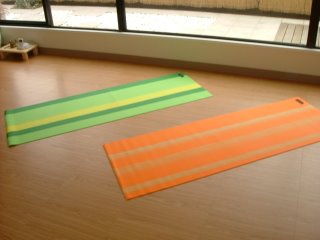I've seen it a dozen times, one of our students comes into the studio and excitedly tells me they've taken the plunge and bought their own mat. "That's great," I say, ".... is this the first time you've unrolled it?" If the answer is "yes," we're in trouble.
Why? Well, in the manufacturing process, most mat companies apply a thin veneer of oil to the surface of the mats. This is to keep the mat soft and supple during the months between its production and your purchase. Mix that layer of oil with a little sweat on your palms or feet, and "downward facing dog" becomes "sliding onto your face dog." Simply put, a brand new yoga mat unrolled for the first time is very, very slippery.
What to do? A lot of people recommend putting your new mat into the washing machine with a mild detergent before using it. That will take care of the problem very quickly, but personally, I think that it makes the mats too sticky, they lose some of their organic feel. I prefer a gentler breaking in period of a few weeks. I like to lay a mat out in the sun, and simply do a lot of yoga on it. Other ideas are putting your new mat under an old one for a few sessions, going over the mat with one of those green backed sponges (using the green scrubby part). Whatever method you use, do it before the lesson so you can enjoy your new mat!
Speaking of which, many people ask me which kind of mat they should buy. Prices range from 1000 yen to 10,000 yen. We have seen really poorly designed mats for 4000 yen, and some very durable, thick mats for 1000 yen, so don't let price alone decide the matter. There are a few factors you should consider.
1. Thickness. Mats come in all kinds of thicknesses, which you will be able to compare easily in the store. If you are a little bony, you should opt for a thicker mat. Gwen uses a double thick Gaiam mat at the studio, but I use a relatively thin mat, because I like to feel the floor more during poses. Another thing to consider is that a thick mat will be harder to fit into yoga bags and (in general) be a little more difficult to travel with.
2. "Grippiness" This is the amount of friction between you and the mat. Thicker mats will offer a much stickier feel because your hand or foot actually sinks into the material. It's difficult to tell how "grippy" a mat is in the store, but you can get an idea from how raised the bumps on the surface are. The higher the bumps, the better the grip. (I once saw a really cheap mat that just had bumps painted on it, and was actually a single, slick surface) Actually, the bumpy style is going out of fashion now, and lots of rubber mats are coming out that offer superior grip. They are usually covered in a grid or squiggles. (the downside to these is that they are heavy and expensive)
3. The "it" factor. This is simply choosing a mat that you connect with. You will be spending a lot of time with it, and having some fondness for the style and color is really important. These days the choices are amazing. You can get every color in the spectrum, funky patterns, or a dragon descending down the mat. So don't just say "this one will do," make it fun, shop around, until you see a mat and say "that's IT!"

Gwen and I just got some traveling mats for the spring and summer. Bright, huh?. And thanks to Rika for getting us a good deal on them!
Patrick


1 comment:
Hi Patrick,
The travel yoga mats are great! I can definitely picture them on the beach. Have you ever tried that?
Keep up the amazing work! I love reading your blogs.
Cheers,
Cheryl
Post a Comment